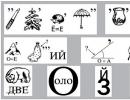Rotation of a body around a fixed axis. Rotational motion of a rigid body Rotational motion of a body
Rotational they call such a movement in which two points associated with the body, therefore, the straight line passing through these points, remain motionless during movement (Fig. 2.16). Fixed straight line A B called axis of rotation.
Rice. 2.1V. Towards the definition of rotational motion of a body
The position of the body during rotational motion determines the angle of rotation φ, rad (see Fig. 2.16). When moving, the angle of rotation changes over time, i.e. the law of rotational motion of a body is defined as the law of change in time of the value of the dihedral angle Ф = Ф(/) between a fixed half-plane TO () , passing through the axis of rotation, and movable n 1 a half-plane connected to the body and also passing through the axis of rotation.
The trajectories of all points of the body during rotational motion are concentric circles located in parallel planes with centers on the axis of rotation.
Kinematic characteristics of the rotational motion of the body. In the same way that kinematic characteristics were introduced for a point, a kinematic concept is introduced that characterizes the rate of change of the function φ(c), which determines the position of the body during rotational motion, i.e. angular velocity co = f = s/f/s//, angular velocity dimension [co] = rad /With.
In technical calculations, the expression of angular velocity with a different dimension is often used - in terms of the number of revolutions per minute: [i] = rpm, and the relationship between P and co can be represented as: co = 27w/60 = 7w/30.
In general, angular velocity varies with time. The measure of the rate of change in angular velocity is angular acceleration e = c/co/c//= co = f, the dimension of angular acceleration [e] = rad/s 2 .
The introduced angular kinematic characteristics are completely determined by specifying one function - the angle of rotation versus time.
Kinematic characteristics of body points during rotational motion. Consider the point M body located at a distance p from the axis of rotation. This point moves along a circle of radius p (Fig. 2.17).

Rice. 2.17.
points of the body during its rotation
Arc length M Q M circle of radius p is defined as s= ptp, where f is the angle of rotation, rad. If the law of motion of a body is given as φ = φ(g), then the law of motion of a point M along the trajectory is determined by the formula S= рф(7).
Using the expressions of kinematic characteristics with the natural method of specifying the motion of a point, we obtain kinematic characteristics for points of a rotating body: speed according to formula (2.6)
V= 5 = rf = rso; (2.22)
tangential acceleration according to expression (2.12)
i t = K = sor = er; (2.23)
normal acceleration according to formula (2.13)
a„ = And 2 /р = с 2 р 2 /р = ogr; (2.24)
total acceleration using expression (2.15)
A = -]A + a] = px/e 2 + co 4. (2.25)
The characteristic of the direction of total acceleration is taken to be p - the angle of deviation of the vector of total acceleration from the radius of the circle described by the point (Fig. 2.18).
From Fig. 2.18 we get
tgjLi = aja n=re/pco 2 =g/(o 2. (2.26)

Rice. 2.18.
Note that all kinematic characteristics of the points of a rotating body are proportional to the distances to the axis of rotation. Ve-
Their identities are determined through the derivatives of the same function - the angle of rotation.
Vector expressions for angular and linear kinematic characteristics. For an analytical description of the angular kinematic characteristics of a rotating body, together with the axis of rotation, the concept rotation angle vector(Fig. 2.19): φ = φ(/)A:, where To- eat
rotation axis vector
1; To=sop51 .
The vector f is directed along this axis so that it can be seen from the “end”
rotation occurring counterclockwise.

Rice. 2.19.
characteristics in vector form
If the vector φ(/) is known, then all other angular characteristics of rotational motion can be represented in vector form:
- angular velocity vector co = f = f To. The direction of the angular velocity vector determines the sign of the derivative of the rotation angle;
- angular acceleration vector є = сo = Ф To. The direction of this vector determines the sign of the derivative of the angular velocity.
The introduced vectors с and є allow us to obtain vector expressions for the kinematic characteristics of points (see Fig. 2.19).
Note that the modulus of the point’s velocity vector coincides with the modulus of the vector product of the angular velocity vector and the radius vector: |cox G= sogvіpa = rubbish. Taking into account the directions of the vectors с and r and the rule for the direction of the vector product, we can write an expression for the velocity vector:
V= co xg.
Similarly, it is easy to show that
- ? X
- - egBіpa= єр = a t And
Sosor = co p = i.
(In addition, the vectors of these kinematic characteristics coincide in direction with the corresponding vector products.
Therefore, the tangential and normal acceleration vectors can be represented as vector products:
- (2.28)
- (2.29)
a x = g X G
A= co x V.
The rotation of a rigid body around a fixed axis is such a movement in which two points of the body remain motionless during the entire time of movement. In this case, all points of the body located on a straight line passing through its fixed points also remain motionless. This line is called body rotation axis .
Let points A and B be stationary. Let's direct the axis along the axis of rotation. Through the axis of rotation we draw a stationary plane and a movable plane attached to a rotating body (at ).
The position of the plane and the body itself is determined by the dihedral angle between the planes and. Let's denote it . The angle is called body rotation angle .
The position of the body relative to the chosen reference system is uniquely determined at any time if the equation is given, where is any twice differentiable function of time. This equation is called equation of rotation of a rigid body around a fixed axis .
A body rotating around a fixed axis has one degree of freedom, since its position is determined by specifying only one parameter - the angle.
An angle is considered positive if it is laid counterclockwise, and negative in the opposite direction. The trajectories of points of a body during its rotation around a fixed axis are circles located in planes perpendicular to the axis of rotation.
To characterize the rotational motion of a rigid body around a fixed axis, we introduce the concepts of angular velocity and angular acceleration.
Algebraic angular velocity of a body at any moment in time is called the first derivative with respect to time of the angle of rotation at this moment, that is.
Angular velocity is positive when the body rotates counterclockwise, since the angle of rotation increases with time, and negative when the body rotates clockwise, because the angle of rotation decreases.
The dimension of angular velocity by definition:
In engineering, angular velocity is the rotational speed expressed in revolutions per minute. In one minute the body will rotate through an angle , where n is the number of revolutions per minute. Dividing this angle by the number of seconds in a minute, we get
Algebraic angular acceleration of the body is called the first derivative with respect to time of the angular velocity, that is, the second derivative of the angle of rotation, i.e.
The dimension of angular acceleration by definition:
Let us introduce the concepts of vectors of angular velocity and angular acceleration of a body.
And , where is the unit vector of the rotation axis. Vectors and can be depicted at any point on the rotation axis; they are sliding vectors.
Algebraic angular velocity is the projection of the angular velocity vector onto the axis of rotation. Algebraic angular acceleration is the projection of the angular acceleration vector of velocity onto the axis of rotation.
If at , then the algebraic angular velocity increases with time and, therefore, the body rotates accelerated at the moment in time in the positive direction. The directions of the vectors and coincide, they are both directed in the positive direction of the axis of rotation.
When and the body rotates rapidly in the negative direction. The directions of the vectors and coincide, they are both directed in the negative direction of the axis of rotation.
DEFINITION: Rotational motion of a rigid body we will call such a movement in which all points of the body move in circles, the centers of which lie on the same straight line, called the axis of rotation.
To study the dynamics of the rotational one, we add to the known kinematic quantities two quantities: moment of power(M) and moment of inertia(J).
1. It is known from experience: the acceleration of rotational motion depends not only on the magnitude of the force acting on the body, but also on the distance from the axis of rotation to the line along which the force acts. To characterize this circumstance, a physical quantity called moment of force.
Let's consider the simplest case.
DEFINITION: The moment of a force about a certain point “O” is a vector quantity defined by the expression , where is the radius vector drawn from the point “O” to the point of application of the force.
From the definition it follows that is an axial vector. Its direction is chosen so that the rotation of the vector around the point “O” in the direction of the force and the vector form a right-handed system. The modulus of the moment of force is equal to , where a is the angle between the directions of the vectors and , and l= r sin a is the length of the perpendicular dropped from point “O” to the straight line along which the force acts (called shoulder of strength relative to point “O”) (Fig. 4.2).
2. Experimental data indicate that the magnitude of angular acceleration is influenced not only by the mass of the rotating body, but also by the distribution of mass relative to the axis of rotation. The quantity that takes this circumstance into account is called moment of inertia relative to the axis of rotation.
DEFINITION: Strictly speaking, moment of inertia body relative to a certain axis of rotation is called the value J, equal to the sum of the products of elementary masses by the squares of their distances from a given axis.
The summation is carried out over all elementary masses into which the body was divided. It should be borne in mind that this quantity (J) exists regardless of rotation (although the concept of moment of inertia was introduced when considering the rotation of a rigid body).
Each body, regardless of whether it is at rest or rotating, has a certain moment of inertia relative to any axis, just as a body has mass regardless of whether it is moving or at rest.
Considering that , the moment of inertia can be represented as: . This relation is approximate and the smaller the elementary volumes and the corresponding mass elements, the more accurate it will be. Consequently, the task of finding moments of inertia comes down to integration: . Here integration is carried out over the entire volume of the body.
Let us write down the moments of inertia of some bodies of regular geometric shape.
| 1. Uniform long rod. | |
| Rice. 4.3 | The moment of inertia about the axis perpendicular to the rod and passing through its middle is equal to |
| 2. Solid cylinder or disk. | |
| Rice. 4.4 | The moment of inertia about the axis coinciding with the geometric axis is equal to . |
| 3. Thin-walled cylinder of radius R. | |
| Rice. 4.5 | |
| 4. Moment of inertia of a ball of radius R relative to an axis passing through its center | |
| Rice. 4.6 | |
| 5. Moment of inertia of a thin disk (thickness b< | |
| Rice. 4.7 | |
| 6. Moment of inertia of the block | |
| Rice. 4.8 | |
| 7. Moment of inertia of the ring | |
| Rice. 4.9 |
Calculation of the moment of inertia here is quite simple, because The body is assumed to be homogeneous and symmetrical, and the moment of inertia is determined relative to the axis of symmetry.
To determine the moment of inertia of a body relative to any axis, it is necessary to use Steiner’s theorem.
DEFINITION: Moment of inertia J about an arbitrary axis is equal to the sum of the moment of inertia J c relative to an axis parallel to the given one and passing through the center of inertia of the body, and the product of the body mass by the square of the distance between the axes (Fig. 4.10).
Rotation of a rigid body around a fixed axis (axis of rotation) It is called such a movement in which the points of the body lying on the axis of rotation remain motionless during the entire time of movement.
Let the axis of rotation be the axis, which can have any direction in space. One direction of the axis is taken as positive (Fig. 28).
![]()
 Through the axis of rotation we draw a fixed plane and a movable plane connected to the rotating body. Let at the initial moment of time both planes coincide. Then, at the moment of time, the position of the moving plane and the rotating body itself can be determined by the dihedral angle between the planes and the corresponding linear angle between straight lines located in these planes and perpendicular to the axis of rotation. The angle is called body rotation angle.
Through the axis of rotation we draw a fixed plane and a movable plane connected to the rotating body. Let at the initial moment of time both planes coincide. Then, at the moment of time, the position of the moving plane and the rotating body itself can be determined by the dihedral angle between the planes and the corresponding linear angle between straight lines located in these planes and perpendicular to the axis of rotation. The angle is called body rotation angle.
The position of the body relative to the selected reference system is completely determined at any time if the equation is given
where is any twice differentiable function of time. This equation is called equation of rotation of a rigid body around a fixed axis.
A body rotating around a fixed axis has one degree of freedom, since its position is determined by specifying only one parameter - the angle.
An angle is considered positive if it is plotted counterclockwise, and negative in the opposite direction when viewed from the positive direction of the axis. The trajectories of points of a body during its rotation around a fixed axis are circles located in planes perpendicular to the axis of rotation.
To characterize the rotational motion of a rigid body around a fixed axis, we introduce the concepts of angular velocity and angular acceleration. Algebraic angular velocity of the body at any moment in time is called the first derivative with respect to time of the angle of rotation at this moment, i.e. . It is a positive quantity when the body rotates counterclockwise, since the angle of rotation increases with time, and negative when the body rotates clockwise, because the angle of rotation decreases.
The angular velocity module is denoted by . Then
Algebraic angular acceleration of the body is called the first derivative with respect to time of the algebraic speed, i.e. second derivative of the rotation angle. We denote the module of angular acceleration by , then
If at , then the algebraic angular velocity increases with time and, therefore, the body rotates rapidly at the moment in time in the positive direction (counterclockwise). At and , the body rotates rapidly in the negative direction. If at , then we have slow rotation in the positive direction. When and slow rotation occurs in the negative direction.
Rotational motion of a rigid body around a fixed axis is such a motion in which any two points belonging to the body (or invariably associated with it) remain motionless throughout the movement(Fig. 2.2) .
Figure 2.2
Passing through fixed points A And IN the straight line is called axis of rotation. Since the distance between the points of a rigid body must remain unchanged, it is obvious that during rotational motion all points belonging to the axis will be motionless, and all others will describe circles, the planes of which are perpendicular to the axis of rotation, and the centers lie on this axis. To determine the position of a rotating body, we draw through the axis of rotation along which the axis is directed Az, half-plane І – fixed and half-plane ІІ embedded in the body itself and rotating with it. Then the position of the body at any moment of time is uniquely determined by the angle taken with the corresponding sign φ between these planes, which we call body rotation angle. We will consider the angle φ positive if it is delayed from a fixed plane in a counterclockwise direction (for an observer looking from the positive end of the axis Az), and negative if clockwise. Measure angle φ We'll be in radians. To know the position of a body at any moment in time, you need to know the dependence of the angle φ from time t, i.e.
|
|
This equation expresses the law of rotational motion of a rigid body around a fixed axis.
The main kinematic characteristics of the rotational motion of a rigid body are its angular velocity ω and angular acceleration ε.
9.2.1. Angular velocity and angular acceleration of a body
The quantity characterizing the rate of change in the angle of rotation φ over time is called angular velocity.
If during a period of time  the body rotates through an angle
the body rotates through an angle  , then the numerically average angular velocity of the body during this period of time will be
, then the numerically average angular velocity of the body during this period of time will be  . In the limit at
. In the limit at  we get
we get
Thus, the numerical value of the angular velocity of a body at a given time is equal to the first derivative of the angle of rotation with respect to time.
Sign Rule: When rotation occurs counterclockwise, ω> 0, and when clockwise, then ω< 0.
 or, since radian is a dimensionless quantity,
or, since radian is a dimensionless quantity,  .
.
In theoretical calculations it is more convenient to use the angular velocity vector  , whose modulus is equal to
, whose modulus is equal to  and which is directed along the axis of rotation of the body in the direction from which the rotation is visible counterclockwise. This vector immediately determines the magnitude of the angular velocity, the axis of rotation, and the direction of rotation around this axis.
and which is directed along the axis of rotation of the body in the direction from which the rotation is visible counterclockwise. This vector immediately determines the magnitude of the angular velocity, the axis of rotation, and the direction of rotation around this axis.
The quantity that characterizes the rate of change in angular velocity over time is called the angular acceleration of the body.
If during a period of time  the increment in angular velocity is equal to
the increment in angular velocity is equal to  , then the relation
, then the relation  , i.e. determines the value of the average acceleration of a rotating body over time
, i.e. determines the value of the average acceleration of a rotating body over time  .
.
When striving  we obtain the magnitude of the angular acceleration at the moment t:
we obtain the magnitude of the angular acceleration at the moment t:
Thus, the numerical value of the angular acceleration of a body at a given time is equal to the first derivative of the angular velocity or the second derivative of the angle of rotation of the body in time.
The unit of measurement is usually used  or, which is also,
or, which is also,  .
.
If the modulus of angular velocity increases with time, the rotation of the body is called accelerated, and if it decreases, - slow When the values ω
And ε
have the same signs, then the rotation will be accelerated, when they are different, it will be slowed down.  By analogy with angular velocity, angular acceleration can also be represented as a vector
By analogy with angular velocity, angular acceleration can also be represented as a vector  , directed along the axis of rotation. Wherein
, directed along the axis of rotation. Wherein
 .
.
If a body rotates in an accelerated direction  coincides with
coincides with  , and opposite
, and opposite  with slow rotation.
with slow rotation.
If the angular velocity of a body remains constant during movement ( ω= const), then the rotation of the body is called uniform.
From  we have
we have  . Hence, considering that at the initial moment of time
. Hence, considering that at the initial moment of time  corner
corner  , and taking the integrals to the left of
, and taking the integrals to the left of  before
before  , and on the right from 0 to t, we will finally get
, and on the right from 0 to t, we will finally get
|
|
With uniform rotation, when  =0,
=0, And
And  .
.
The speed of uniform rotation is often determined by the number of revolutions per minute, denoting this value by n rpm Let's find the relationship between n rpm and ω 1/s. With one revolution the body will rotate by 2π, and with n rpm at 2π n; this turn is done in 1 minute, i.e. t= 1min=60s. It follows that
|
|
If the angular acceleration of a body remains constant throughout its motion (ε = const), then the rotation is called equally variable.
At the initial moment of time t=0 angle  , and the angular velocity
, and the angular velocity  (
( - initial angular velocity).
- initial angular velocity).  ;
; =ε
=ε  . Integrating the left side of
. Integrating the left side of  before
before  , and the right one from 0 to t, we'll find
, and the right one from 0 to t, we'll find
Angular velocity ω of this rotation  . If ω and ε have the same signs, the rotation will be uniformly accelerated, and if different - equally slow.
. If ω and ε have the same signs, the rotation will be uniformly accelerated, and if different - equally slow.


 .
. .
. .
.



